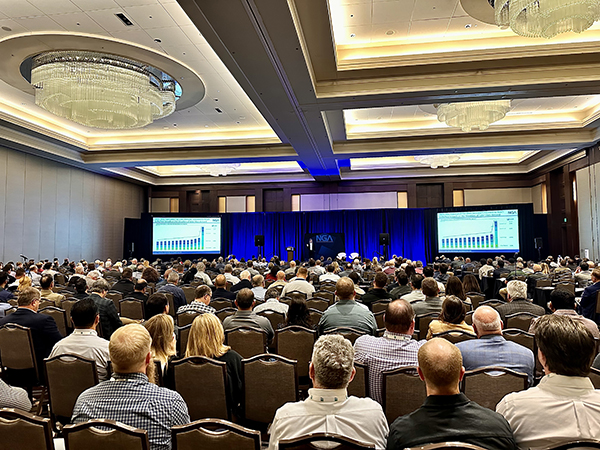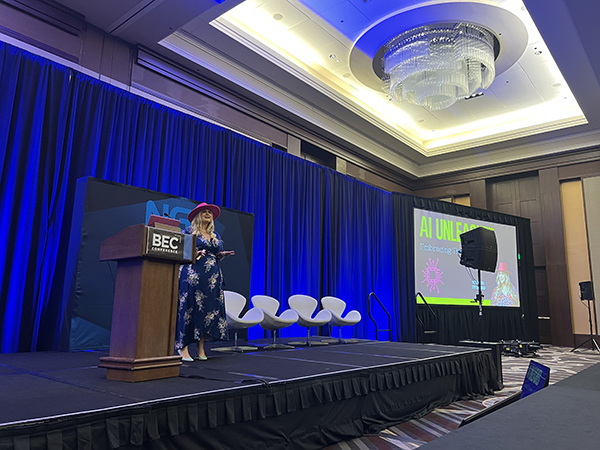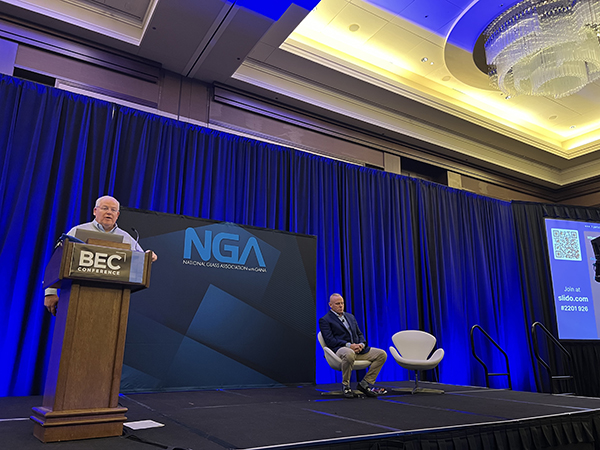
This year's BEC Conference, held March 3-5 in Nashville, brought together the experts of the glass industry, as well as about 800 attendees, for a conference full of critical information, tabletop displays and invaluable networking time.
New, "disruptive" technologies can be labor-saving
President of Harmon Inc. Troy Johnson gave the conference's keynote presentation on day one, entitled "Disruption is Coming? Are You Ready?"

Johnson says that new entrants to the industry will be "the disruptors" to the incumbents. To prep for disruption, companies need to have a strong foundation; including organizational health and a solid business strategy. Companies should also strengthen their operating systems and identify unmet customer needs. Whereas individuals in the industry should embrace a growth mindset; including skill acquisition, digital literacy and embracing change.
"Change has to come in some form. At best, it will be transformational. At worst, it will be disruptive," Johnson says. "View this as an opportunity; not an obstacle."
Stefanie Couch, founder of Build Women, gave the keynote presentation during the second day of the conference on the importance and power of artificial intelligence and how it can "change the fate of your business."
Couch says that AI can help alleviate the daily, more tedious tasks in business and can aid in the ongoing labor shortage. She walked attendees through a live tutorial on how to use ChatGPT, which is an AI tool that can write text for the user, including formulating interview questions, writing jokes, creating content for speeches and provide links to timely, peer-reviewed research.
Companies can automate things like FAQs, Google review responses, missed calls and more to help appeal to customers and take work off employees' plates.
President of Vitro Architectural Glass Ricardo Maiz presented on the state of the flat glass industry. Maiz says float glass for solar energy generation is expected to see a large increase between now and 2032, with float glass in general anticipating an 8% per year growth in that same time frame.
Conley Oster, co-founder of Raise Robotics, spoke at BEC about robotics in the construction industry. Conley says today's robotics are more advanced than in the past because robots can now operate in dynamic environments using AI; they are constantly improving through the process of machine learning. Incorporating robotics can help with a lack of skilled labor and create a more efficient workplace, he says.
Recruit the next generation by "planting glass seeds"
NGA's Vice President of Workforce Development Jenni Chase and Vice President of AllStar Glass Jodi Martinez discussed recruitment of the next generation.
"The construction industry as a whole is facing labor challenge. The glazing industry faces the additional obstacle of being slightly unknown. So our first challenge is just educating people about the glass and glazing trade," says Chase.

Chase and Martinez say that high school students looking to pursue the trades after graduation are an important target for the industry. These students know they want to join the trades, but may not even know the glass industry is an option, or may not know much about it.
Martinez says companies have to "plant the glass seeds," because even if one student ends up not being interested, they may have a younger sibling, a friend, a cousin, etc., who may hear about he industry from them or see their flyer and become interested in it.
More information on how to attract young people to the glass industry can be found here.
70% of workplaces are impacted by the opioid crisis
Cal Beyer, certified wellness practitioner for SAFE (Stop the Addiction Fatality Epidemic) and David Argus, director of operations at Karas & Karas Glass Co., gave a poignant and powerful presentation on addiction treatment and recovery and how it pertains to the construction industry. The construction industry has the second highest rate for employees with heavy drinking/binge drinking issues, behind mining. According to the American Addiction Center, construction also has the second highest rate of substance misuse disorder, behind accommodation/hospitality and food service.
During a poll of the room, most attendees said they were "unsure" how the opioid epidemic impacted their colleagues and employees, despite the fact that 70% of workplaces have been impacted by opioid crisis, according to the National Safety Council. "That's not okay. Your employees are the most important part of your organization. How can you just not know?" Argus says.
Beyer and Argus said employers and employees need to be having candid and open conversations with each other about the issue of addiction. Employee engagement is paramount to identifying this issue in your peers and helping those suffering.
Employee engagement, and engaging architects
Tom Jackson, president and CEO of Steel Encounters, laid out everything he's learned in the past six years about employee engagement. He says the three main reasons employees lose engagement are anonymity, irrelevance and "immeasurement," meaning they don't have a measurement of how well or how poor their work has been. Jackson says everyone wants to feel like their job matters to someone and employees also need to be able to gauge their process over time. Among other things, Jackson says education and career development, and a simple "thank you" will always go a long way.
Principal Architect for the SLAM Collaborative Keith Fine and Director of Preconstruction for Aragon Construction Matt Aragon sat down together to tell attendees about the importance of architects and glaziers working together and collaborating, despite their "traditionally cat and dog relationship."
“When I start a project, in that first one to two months, I want to be extremely nice and develop an authentic connection. Keep it light, be real. I also want to be the most responsive person they’ve [glaziers] met. This helps mobilize our team and helps bring the team up. This way, if I have a delay or a bottleneck, they’ll be pretty flexible with that,” Fine says.
Aragon says glaziers want that same thing back. Glaziers want technical efficiency, fast responses and a good working relationship.
Fine shared a recent example of working with a graphic designer to come up with the glass design for an oncology building project. Aragon and his team came in “with the superman cape” to bring that vision to life. Aragon says he had to look at it as “a piece of art, rather than a façade.”